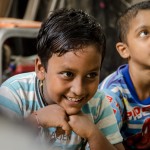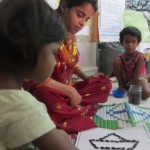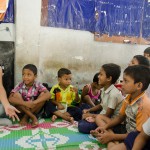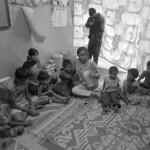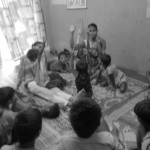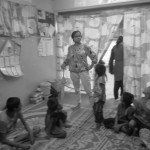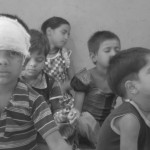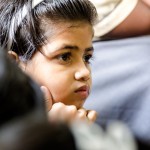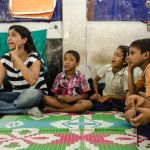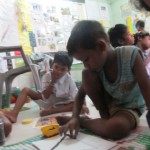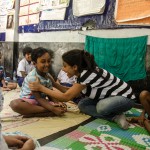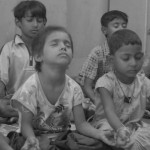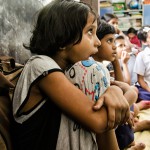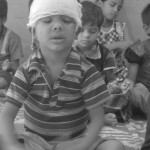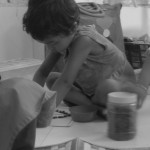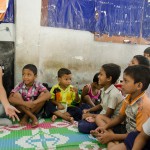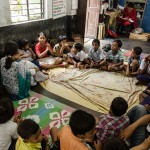(What Grandpa Told the Children)
The moon? It is a griffin’s egg,
Hatching tomorrow night.
And how the little boys will watch
With shouting and delight
To see him break the shell and stretch
And creep across the sky…
…Yet gentle will the griffin be
Most decorous and fat,
And walk up to the Milky Way
And lap it like a cat.
The moon becomes a griffin’s egg, his shadow a catlike monster and the monster laps up the vast star spangled sky canopying above—stories and poems open up a world full of possibilities, especially for a child. Imagination is wedded with hope. Meaning of reality is collected in a nugget of wisdom that can be bitten into, tasted, absorbed and gained nourishment from. Unlike value-education classes that make morality sound like an irritable aunt, stories convey morals effortlessly.
Share Stories Open Minds— a project conceived by PeaceWorks uses this powerful medium to reach out to the underprivileged children in our city. With a handful of dedicated volunteers, unlimited zeal and the limited resources of The Seagull Foundation for the Arts, it has made the act of storytelling more meaningful and attractive. And after a year and a half of listening to stories, the children now fight shy of their fear and want to become storytellers themselves. A joy that deserves celebration! So the idea of Golpo Mela took root in our minds and has now spread to others—schools, NPOs and NGOs. The Mela would give the children a platform to showcase their storytelling skills to a larger audience. We decided to give them basic training in the art of storytelling so that they may make best use of this opportunity.
Purbani Das, programme officer at The Seagull Foundation for the Arts has recently finished the first round of training in the centres. The experience has been insightful and the impact splendid, although a little checkered. Each centre has its own flavour and taste, not surprisingly the children have responded differently in different centres. Further, children have their own peculiarities and it is up to the storyteller to use these peculiarities to his or her advantage.
When Purbani began her training at the Saltlake centre, she was a bit tensed. The Childcare Home shelters children of all ages and even older women with disabilities. To catch their attention—a room full of boisterous young adults and women—wasn’t easy. But part of being a storyteller is having the ability to make the best of the situation given to you. Thump your drum if you are in a market place, dance to the rhythm of the rain if it pelts on you—oral arts are limited only by the imagination of the performer, for a performer you must be in order to arrest and keep the attention of your audience.
The first prop to use is your own body, spread your hands and you become a tree, angle them at ninety degrees and you are a grandfather clock. And then there are simple everyday objects beckoning you, persuasively. At the centre, Purbani used her scarf and displayed imaginative ways of using this simple prop—a robber by tying it up like a bandana, a farmer with hands holding an imaginary hoe, or a bride aptly blushing and the children of the centre rolled on the floor with laughter. However an animated story and a lively storyteller is not all, the story has to be interesting as well. She narrated the heartwarming story called The Giving Tree. It is about a beautiful relationship between a tree and a little boy. Inflecting her voice and making endearing faces she narrated the story. At end the children chorused the “the moral of the story”. Spontaneous! That is the thing with sowing seeds of an idea— they have to be done very carefully, contrived with love and pleasure. Patience is the key. Purbani would use this method in the other seven centres, varying them a little to suit her fastidious audience and at the same time give them the training without making it sound like an instruction.
Do this, do that—solve your math sum, remember the Panipat dates, the children in the centres experience the same consternation faced by children elsewhere. But there lives are harder. Their circumstances being violent and difficult, they often experience angst that needs a physical release. In centres such as Gariahat, the children exhibited obvious signs of trouble. Soothing them with a song or getting them to show a dance was a way forward. Having satisfied their irrepressible urge to show off their dancing skill, Purbani began her stories. There too popular folk narratives like Barmecide’s Feast worked wonders; after all it had all the ingredients to arrest a child’s mind—imaginary feast, witticism and fun. Then she would ask one of them to narrate a story. At the end she would point out the lacunae in their narration or praise where needed. Honesty! Children have an ear for that, they can spot a lie and they inevitably dish it out to the giver. Perhaps this is difficult but it isn’t a challenge we don’t like. Ones who refused to narrate stories were requested to enact a situation; the idea was that they learn the art of speaking and communicating effectively. Storytelling is at the root—the art of communicating ones worldview—be it real or imaginative. This impulse drives Golpo Mela.
Centres such as Tollygunge and Disha had extremely responsive children. After the performance of both the trainer and the children—the children were engaged in conversation. This persuaded them to open up and speak freely. Their intelligent responses reaffirm that children need to be exposed to more and more creative forms of expression. Although what they lacked in exposure, the children of the centres made it up by exhibiting enthusiasm and interest. They lapped up Purbani’s stories as hungrily as the proverbial griffin and came up with witty answers. Some volunteered to tell stories that gave the trainer an opportunity to suggest enhancements.
However, some centres such as Alipore and Kalighat had children who were extremely shy. Ice was thicker and ice-breaking more challenging. Yet the good stories saw them laughing. A deeper engagement with children of these centres over a long period of time would have far reaching impact. A challenge that our dedicated volunteers are more than equipped to handle.
This is just the first round of training. Our volunteers have taken the role of further training the children upon themselves. A second round of training by Purbani would effectively influence the children. An experience that we are looking forward to…
A report by Shailza Rai

